pH Food Fight Experiment, Aquashock (no it's not a new super hero) and choosing the best electrode. Read Here... pH Food Fight Experiment, Aquashock (no it's not a new super hero) and choosing the best electrode.
pH Food Fight Experiment, Aquashock (no it's not a new super hero) and choosing the best electrode. Read Here... pH Food Fight Experiment, Aquashock (no it's not a new super hero) and choosing the best electrode. |
1300 737 871I wanted to remind you that we have an automatic 30 day account policy for all Government Departments, Universities and Schools, just a little way we make things easier for you. The end of financial year has everyone rushing to get purchase orders approved and orders placed before the June 30th deadline hits. And to sweeten the deal even more we are offering FREE Express Post shipping on all nonbulky items for the month of June, so get in quick you still have a week and a half to go. This month the guys experimented with a pH meter and the contents of the Instrument Choice Kitchen with some very interesting results. If you have any suggestions about experiments you would like us to conduct in the future then please email them through. Remember; if you have any questions regarding tests you need to conduct or specific instrumentation please give us a call. Until next month…Tyson Grubb | |||||||||||||
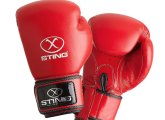 pH Food Fight!This month it’s a food fight in the Instrument Choice lab! We’re matching up some common kitchen foods, head to head, to see which food in the kitchen is the most acidic. Dentists are always telling us to avoid highly acidic foods, but how do you know which is more acidic and which option is a better for your teeth? Read on to find out! | |||||||||||||
Equipment used
Method For each product a sample was placed in a clean dry container. Prior to use, and between each measurement, the meter was calibrated at pH4, pH7 and pH10 using the buffer solutions. This was to ensure that the readings taken were as accurate as possible. After calibration, the pH meter was then used to take a reading. The readings were written down once the readings had stabilised. The meter was then rinsed with deionised water between each measurement. Samples tested We tested Coke zero, soda water, milk, yoghurt, orange juice (shelf stable), apple juice (shelf stable), traditional sauerkraut, gherkin, lemon juice and lime juice. Results Round 1 Coke vs Soda water 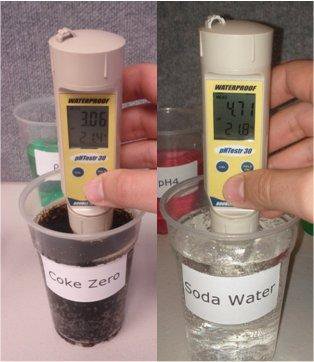
Round 2 Milk vs Yoghurt 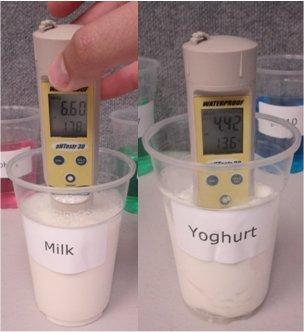
Round 3 Orange juice (shelf stable) vs Apple juice (shelf stable) 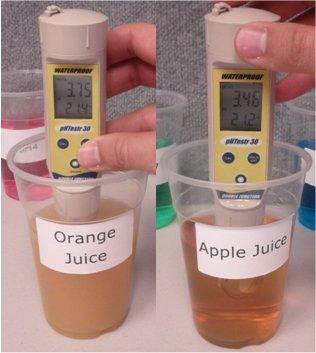
Round 4 Traditional sauerkraut vs gherkin 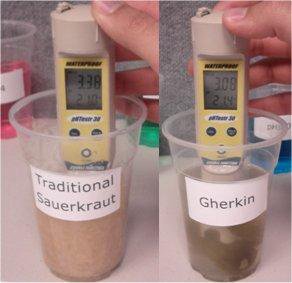
Round 5 Lemon juice vs Lime juice 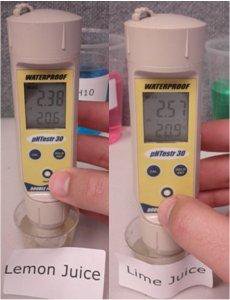
The following items we don’t recommend you drink, but we had them lying around so we thought we’d test them: 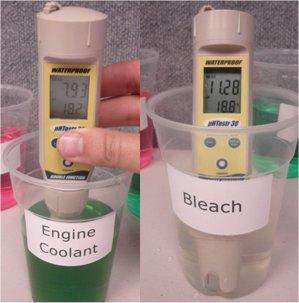
Samples tested All of the foods we tested were acidic to some extent. Milk was the least acidic with a pH of 6.60 and lemon juice was the most acidic with a pH of 2.38. Interestingly, all of the long life/shelf stable foods (orange juice, apple juice, sauerkraut and gherkins) had a pH below 4.6. This is important because above 4.6pH (in moist and anaerobic conditions which are typical of canned foods), the nasty Clostridium botulinum bacteria can replicate and create a toxin that can cause paralysis and sometimes even death in humans. It is also worth noting that a difference of one pH unit means a tenfold difference in acidity. For example in the second test, yoghurt, with a pH of 4.42 is more than 100 times more acidic than milk with a pH of 6.60. It’s also interesting to note that lemon juice is 10,000 times more acidic than milk! We hope you’ve found this month’s newsletter enjoyable and informative, and remember, if you have any questions, please feel free to contact one of our scientists! | |||||||||||||
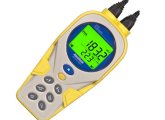 SPER and the Aquashock RangeWe were recently appointed the authorised Australian distributor for SPER Scientific, a US based company that has been manufacturing reliable Instrumentation for 30 years. For this article we will run through their Aquashock water quality meter range and go through the features they offer. We will also provide details on a few of the electrodes from our range that can be used for applications commonly requested by our customers. Introducing the Aquashock meters:The Aquashock meters were introduced to the SPER Scientific range in 2012 and allow customers access to a cost effective range of shockproof and waterproof water quality instruments. Whilst this newsletter is aimed at pH meters it is worth noting the Aquashock range is available in a dissolved oxygen kit, a water purity kit that can measure conductivity and total dissolved solids, a pH kit and a pH & ORP kit. These meters are aimed at the water quality field for applications such as wastewater monitoring, run off testing and industrial quality control. The Aquashocks feature an integral soft-grip outer layer that will provide a firm grip even in slippery conditions. They are a fully shockproof unit and will withstand drops from about a metre high. Our manager Tyson actually tested this when he went to visit the SPER Scientific offices in February and found the meter to be undamaged and useable even though he’d thrown it at the ground from a metre in the air. The full Aquashock range is IP67 rated when the supplied Aquashock probes are used, meaning it is fully dustproof and waterproof to a depth of 1 metre. It will also float if dropped which means you won’t have to worry about going for a swim to recover it. The Aquashocks also have the added advantage of having a rechargeable battery that provides 200 hours of service per charge (80 hours for the water purity kit). The kits come supplied with everything you will need to get you started including calibration solutions, carrying case, AC adapter along with the applicable electrodes. So, if you want an intuitive, robust and cost effective meter it is hard to look past the Aquashock range. | |||||||||||||
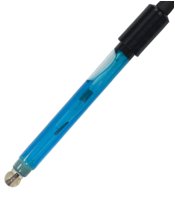 Selecting an electrode for your application:The common misconception when it comes to pH measurement is that the meter is more important than the electrode. Your electrode selection should be based on your sample and application. A high end meter with an electrode that isn’t suited to the application will almost always be outperformed by a basic meter with an electrode that is suited. Whether it be monitoring the pH of your cheese or testing the levels in high sodium concentration solutions there are electrodes to suit most applications. We will go through a few of our electrode and provide details on the applications that they can be used for. | |||||||||||||
EC-FC-72521-01B* - Plastic Body pH Electrode Single junction, gel filled and plastic body electrode that is both low cost and virtually maintenance free. This electrode is ideal for checks in pools and spas, hydroponics along with most laboratory based applications where the electrode is not at risk of clogging. EC-620-131 – Open pore glass body pH electrode Ideal for customers looking to measure TRIS buffers, yoghurt, emulsions and viscous samples. This is because it features a single pore capillary reference junction that is about 200 times larger than a typical ceramic junction. This unique construction protects the electrode from clogging even in difficult samples. EC-620-133- Spear Tip Electrode This electrode features the same single pore capillary reference junction as the EC-620-131, however it features a spear tip which is ideal for insertion into semi solid food products. The most common use for this electrode is measuring cheese and small volume samples. EC-FG74519/01B – Rugged glass body pH electrode At pH values above 12 the concentration of hydrogen is very small. When there are so few hydrogen ions present, the electrode will "mistake" any sodium ions present in the solution for hydrogen ions. To combat this the EC-FG-74519-01B has specially formulated glass to minimise sodium error. This electrode should be used in high sodium applications. This isn’t our whole range of electrodes So if you have an interesting or unusual application that isn’t listed and you are not sure which electrode will best suit, please send us an email or phone us on 1300 737 871 and one of our friendly Scientists will be there to give you a hand. | |||||||||||||
